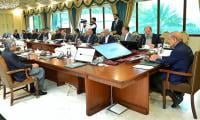Comment
LAHORE: Though overall economy has somewhat strengthened, our exports have declined by over 20 percent in past four years and scarcity of greenfield projects in last two decades indicates share of manufacturing in the GDP is falling.
There is a need to revisit the policies governing the manufacturing sector. Exporters complain of high power rates and nonpayment of refunds. The manufacturers, catering to the needs of domestic market, complain of huge under-invoicing, which enables importers to cut cost and thus dent competitiveness of the formers.
This government has almost resolved the issues of macroeconomic stability but it’s not enough. It has to find a way to facilitate the manufacturers sitting on old technologies to upgrade their units. Instead of subsidies to make inefficient technologies viable the government should provide incentives for upgrading technology in various manufacturing sectors.
The major reasons for the reduced level of contribution by manufacturing has been the inability of the country to build and maintain competitiveness needed to meet the global challenges as well as to develop a larger domestic market through low cost production.
India, under Narendra Modi government, took some prudent steps to improve its ranking in ‘ease of doing business’ index from over 140th to 100th.
Pakistan’s position has been declining regularly in the past decade. Recently the Punjab government has taken some steps in various fields that are likely to improve the country’s standing next year but the ranking would substantially improve if all the provinces match the steps taken by Punjab.
It is a known fact that besides carrying the major burden of creating employment opportunities the effect of improvement in manufacturing sector goes far beyond the goods provided by it.
Manufacturing sells goods to other sectors and in turn buys materials and services from them for growth and development. It spurs demand for everything from raw materials to intermediate components. It engages information technology, software, financial, health, accounting, transportation, and other services in the course of doing business.
Policymakers should realise that powerful developments around the globe as well as within the country have impact the manufacturing sector. Substantial reduction in trade barriers worldwide and Pakistan, particularly in respect of manufactured goods, was the first change that impacted domestic industries in the late nineties.
Then technology revolution bore on productivity and lowered costs. The most significant affect on domestic industries was the emergence of low cost manufacturing hubs like China, India, and other South East Asian countries.
Pakistan unfortunately missed this opportunity despite having potential because of its obsolete manufacturing technology. The manufacturing sector was unfortunately unable to read the global trends and adjust to cope with these challenges. The government as well failed to introduce a viable manufacturing policy.
The competing economies have left us far behind and now the manufacturing sector in Pakistan have to grow at 20 percent per annum for at least five years to absorb the backlog of unemployed work force. Moreover it would also help the country in closing the gap with competing economies in economic development. To achieve this growth rate various measures need to be taken.
First the country would need massive investments in infrastructure that has been adequately made in last five years through CPEC and other development initiatives. But the needed investment has still not been committed.
The country would have to acquire as well as promote development of state-of-the-art technology to compete in the world markets.
Exploration of both foreign and domestic markets would be essential for disposal of products produced at the rate of envisaged growth of industry. It is understood that achievement of the high level of growth calls for huge supply of energy resources as well as other raw materials and inputs for its industry in the years to come.
We would have to formulate our foreign policy based on trade instead of aid. Our external economic relations will have to increase trade with other countries both in goods and services.
The foreign policy should focus on attracting foreign investment capable of providing capital as well as technology for upgrading infrastructure and manufacturing capacities.
Sheikh argued that the government should have maintained stable petroleum prices
MARI has successfully drilled and tested the third appraisal well in the Ghazij formation in the Mari D&PL
Gold rates decreased by $17 to $2,395 per ounce in the international market
Company's revenue saw a 13.9% year-on-year increase, reaching Rs49.2 billion, up from Rs43.19 billion in the same...
A man counts US dollars in a money exchange shop in Dhaka. — AFP/FileLAHORE: The first thing that the government...
Power generation stood at 8,741 gigawatt-hours or 11,749 megawatts in March







